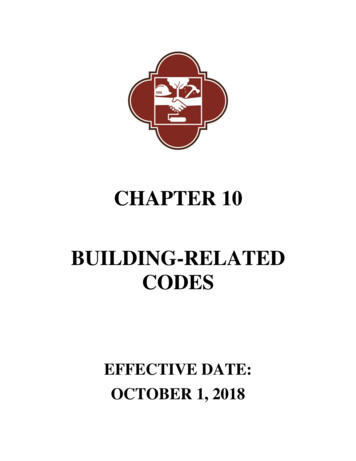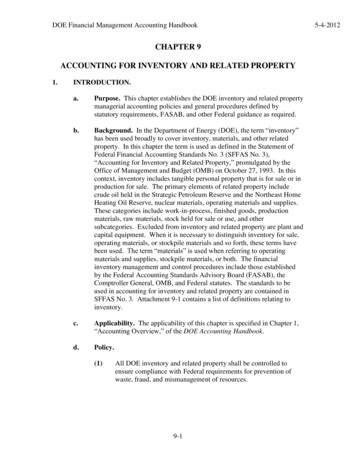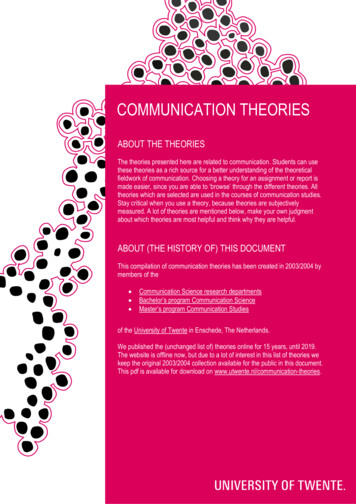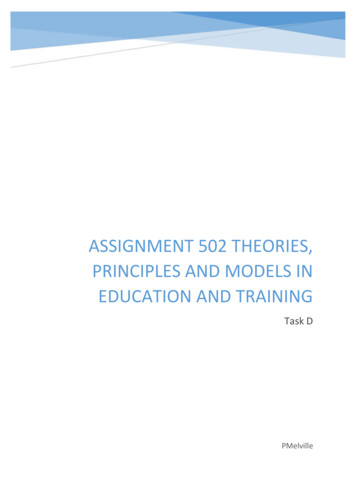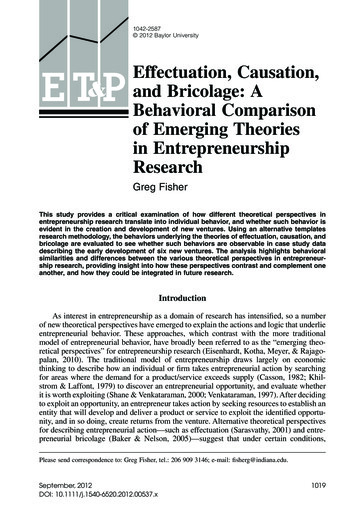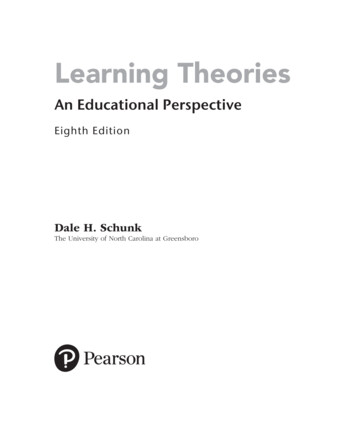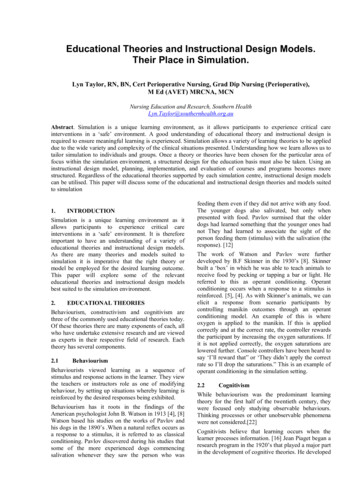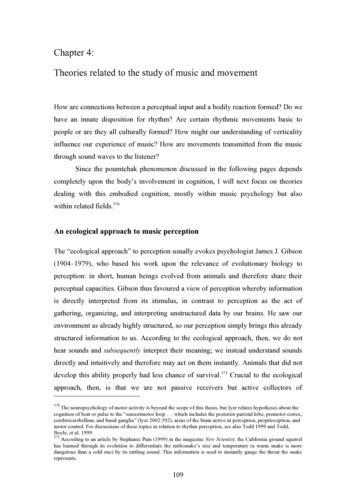
Transcription
Chapter 4:Theories related to the study of music and movementHow are connections between a perceptual input and a bodily reaction formed? Do wehave an innate disposition for rhythm? Are certain rhythmic movements basic topeople or are they all culturally formed? How might our understanding of verticalityinfluence our experience of music? How are movements transmitted from the musicthrough sound waves to the listener?Since the poumtchak phenomenon discussed in the following pages dependscompletely upon the body’s involvement in cognition, I will next focus on theoriesdealing with this embodied cognition, mostly within music psychology but alsowithin related fields.370An ecological approach to music perceptionThe “ecological approach” to perception usually evokes psychologist James J. Gibson(1904–1979), who based his work upon the relevance of evolutionary biology toperception: in short, human beings evolved from animals and therefore share theirperceptual capacities. Gibson thus favoured a view of perception whereby informationis directly interpreted from its stimulus, in contrast to perception as the act ofgathering, organizing, and interpreting unstructured data by our brains. He saw ourenvironment as already highly structured, so our perception simply brings this alreadystructured information to us. According to the ecological approach, then, we do nothear sounds and subsequently interpret their meaning; we instead understand soundsdirectly and intuitively and therefore may act on them instantly. Animals that did notdevelop this ability properly had less chance of survival.371 Crucial to the ecologicalapproach, then, is that we are not passive receivers but active collectors of370The neuropsychology of motor activity is beyond the scope of this thesis, but Iyer relates hypotheses about thecognition of beat or pulse to the “sensorimotor loop . . . which includes the posterior parietal lobe, premotor cortex,cerebrocerebellum, and basal ganglia” (Iyer 2002:392), areas of the brain active in perception, proprioception, andmotor control. For discussions of these topics in relation to rhythm perception, see also Todd 1999 and Todd,Boyle, et al. 1999.371According to an article by Stephanie Pain (1999) in the magazine New Scientist, the California ground squirrelhas learned through its evolution to differentiate the rattlesnake’s size and temperature (a warm snake is moredangerous than a cold one) by its rattling sound. This information is used to instantly gauge the threat the snakerepresents.109
information. Gibson writes: “Perceiving is an act, not a response, an act of attention,not a triggered impression, an achievement, not a reflex.”372 He links perception andaction very closely in any human encounter with the outside world.In his book Ways of Listening from 2005, Eric Clarke draws upon Gibson’stheories in relation to meaning in music:The interdependence between perception and action that is emphasized in ecologicaltheory suggest that every perceptual experience will bear the trace of an actioncomponent. In the case of music, these traces are not hard to find—they are displayedovertly in the foot-tapping, head-nodding, and body-swaying that are commonlyobserved in even the most constrained circumstances of the Western art music373tradition.The correspondence between the musical poumtchak pattern and the poumtchakmovement pattern seems to resonate with the perception-action cycle that Clarkeobserves.374 The musical sounds may be perceived by the culturally trained listenervia an intuitive understanding of the movements related to them: the bass drum causesdownward movement, while the hi-hat causes upward movement, in a similar manneras humans instantly turn around when hearing a startling sound from behind.But how is this intuition acquired? How do the culturally trained listenerknow, consciously or unconsciously, that this musical pattern corresponds to a certainway of moving?PERCEPTUAL LEARNING PROCESSESGibson sees all knowledge as an extension of our perception:The child becomes aware of the world by looking around and looking at, by listening,feeling, smelling, and tasting, but then she begins to be made aware of the world aswell. She is shown things, and told things, and given models and pictures of things, andthen instruments and tools and books, and finally rules and short cuts for finding outmore things. Toys, pictures, and words are aids to perceiving, provided by parents andteachers. They transmit to the next generation the tricks of the human trade. The labors375of the first perceivers are spared their descendants.Through perceptual learning processes our knowledge concerning the world aroundus matures.376 These processes are both individual and guided expeditions. Clarke372Gibson 1979:149.Clarke 2005:62.374See Clarke 2005:19ff for further discussion of the perception-action cycle.375Gibson 1979:258; emphasis in the original.376See Clarke 2005:22ff.373110
observes ways that unguided perceptual learning may be productive concerningabilities in music. Concerning a child’s unsupervised investigation of loudness andpitch on a xylophone, he writes: “Perceptual learning about pitch height, dynamics,and timbre resulting from manual/aural exploration leads to further perceptuallearning about the possibilities of tune building, or expressive function.”377 Visualimpressions, sounds, odours, and so on become familiar to us over time, while actionsrelated to them are learned through our own experiences and through interactions withothers. Yet this is not cumulative information intended to organize a non-structuredenvironment, according to Clarke: “The ecological approach views perceptuallearning as progressive differentiation, perceivers becoming increasingly sensitive todistinctions within the stimulus information that were always there but previouslyundetected.”378 Through our perceptual learning processes, then, we improve ourability to differentiate – that is, by hearing and seeing new details in the perceptualinput, we can recognize and pay attention to subtle differences in more productiveways.The capability of the poumtchak pattern to trigger a certain dominantmovement pattern depends, of course, upon the cultural setting.379 Among otherthings, this setting comprises localized knowledge acquired by the participants as wellas codes of accepted or expected behaviour, especially that related to moving ordancing to music. Through parallel perceptual learning processes, where connectionsbetween a rhythmic pattern and a pattern of movement may be experienced, thephenomenon of the poumtchak pattern becomes clearer.380 And as one listens more,one recognizes more patterns in more complex mixes, or minor differences in timingor sound-related realizations.Producers of dance music use the knowledge they have acquired throughpartaking of a specific culture – that is, their experiences from perception-actioncycles that lead to perceptual learning. Their own experiences of moving to music,and, to a certain extent, the visual input of watching others, can inform the processes377Clarke 2005:23.Clarke 2005:22; emphasis in the original.379Experiments conducted by Hannon and Trehub (2005) among North American adults and six-month-oldinfants, and adults of Bulgarian or Macedonian origin on perceptual biases for simple-meter or complex-meterpatterns indicated that such predispositions were culturally acquired.380The account of the South African deejay (note 340, page 94) emphasizes these relations between localizedknowledge and behaviour; a certain type of movement is seen as more “rhythmic” in a specific cultural setting,and those in the setting will learn perceptually the actions that follow the input.378111
of producing. Within the electronic dance music scene, deejays who also produce canbring their experiences from deejaying (and dancing) to the making of music. Withthat background they can better anticipate how, for example, the build-up orbreakdown section of a track will be experienced. In such sections, poumtchakpatterns are often only partially present. The four-to-the-floor bass drum pattern or theupbeat hi-hat pattern are often gradually introduced in a build-up and then removed,totally or partly, in a breakdown. To predict the success of this crafting of tension andrelease, a specific, graphic sense of related body movements is particularly useful.381Mark Butler’s discussion of a phenomenon from electronic dance music hecalls “turning the beat around” relates to the ecological approach to musicperception.382 In the buildup in Underworld’s 1998 track Cups, the synthesizer themethat starts at 0:44 (after an introduction with an undefined rhythmic pulse) indicates a4/4 meter with an unambiguous starting point. After four measures, a hi-hat enters onwhat seems to be the downbeats, reinforcing the synthesizer’s rhythmic structure. Butat 0:59 a pattern with a bass drum and a snare drum enters between what we hadassumed were the downbeats, and following the introduction of more conflictingmusical elements we are ultimately forced to give up the synthesizer’s structure – thebeat has, in fact, been turned completely around. This has interesting ramifications forthe relevant body movements, because the first part of the track exposes us to aflawed perceptual learning process. The hi-hat on the downbeat is “wrong” in relationto the poumtchak pattern, and the continuation of the track confirms this defect. Theproducers are probably playing with the established cultural codes, and inviting othersto share in the fun. Deejays who are familiar with the track can demonstrate their(exclusive) knowledge by beatmixing it without “turning the beat around,” whiledancers in the same way might move contrary to expectation at the beginning and beperfectly aligned with the music at 0:59.ADAPTATION AND AFFORDANCEIn ecological theory, “adaptation” often refers to how animals and humans haveadapted as organisms to new environments through evolutionary processes that favour381The Norwegian deejay Gaute Drevdal emphasizes the significance of the “push and pull” – that is, how adeejay/producer uses different music or different musical features to push the audience on the dancefloor or pullback to produce relaxation and experiences towards other features in the music. Drevdal compares this totraditional rhetorical techniques for leading or controlling crowds (e-mail received 10 October 2006).382Butler 2006:141.112
certain qualities over others. Clarke describes such processes concerning music:Human beings have exploited natural opportunities for music making (the acousticalcharacteristics of materials and the action-possibilities of the human body) and havealso adapted themselves to those opportunities, and enhanced those opportunities,through tool-making of one sort or another—from drilled bones, through catgut and383wooden boxes to notational systems, voltage-controlled oscillators, and iPods.Thus head-nodding or foot-tapping may be seen to arise from the earliest collectivehuman activities, such as dancing, celebrating, hunting, or fighting. In his bookKeeping Together in Time, William McNeill even sees the human ability to move insynchrony while making rhythmic noises as helpful to our survival as a species.384Adaptation also describes more intimate adjustments, in life situations wherewe change our behaviour to adapt to new cultural settings.385 Such adaptation mayinvolve a laborious renegotiation with new perception-action cycles that that were notpart of our upbringing. In particular, perception-action cycles where sounds andmovements interact may be so fundamentally grounded in our behaviour that newones present a major challenge. Going to a club for the first time can start one suchcycle, and acceptance in this new milieu may depend on the ability to behave in“correct” ways; as a “true” clubber.386 The cycles related to the poumtchak patterncomprise exactly this sort of shared knowledge related to a specific culture.387Gibson’s concept of “affordance” may also shed light on the poumtchakphenomenon:388 “The affordances of the environment are what it offers the animal,what it provides or furnishes, either for good or ill It implies the complementarityof the animal and the environment.”389 Elsewhere, he writes, “It is a combination ofphysical properties of the environment that is uniquely suited to a given animal—tohis nutritive system or his action system or his locomotor system.”390 A musicalinstrument, therefore, “affords” its playing, and this function is part of our perceptionof the object. The object may possess other affordances, or opportunities, as well: the383Clarke 2005:21–22.McNeill 1995:26ff.385As a new music student at the university in 1986, I soon noticed that I was the only person in the auditoriumnodding my head to the music whenever the played examples moved into an isochronous rhythm. Eventually, mynodding would diminish, at least in my academic surroundings.386Thornton labels such issues “embodied subcultural capital” (Thornton 1995:11–12).387Westerners of a certain age may connect the poumtchak pattern to certain body movement even outside of clubculture. This is supported by the survey in chapter 3. Club culture, however, refines these movements further inways unique to itself.388The origin of the concept is described in Gibson 1979:138ff. Also see Clarke 2005:36ff and Jensenius 2007:16.389Gibson 1979:127.390Gibson 1977:79. Humans, of course, are among Gibson’s “animals” (as opposed to plants, for example).384113
piano affords a place to put your glass of wine; the trombone affords the ability toreach something from high up on a shelf; the electric guitar affords protection from anangry dog. Gibson does not limit the affordance to either absolutely subjective orobjective relations; it may be totally contextually dependent, completely basic anduniversal, or, as in most cases, a combination of the two.When percei
theories in relation to meaning in music: The interdependence between perception and action that is emphasized in ecological theory suggest that every perceptual experience will bear the trace of an action component. In the case of music, these traces are not hard to find—they are displayed overtly in the foot-tapping, head-nodding, and body-swaying that are commonly observed in even the .

